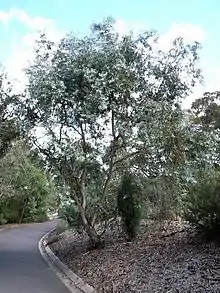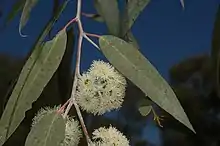| Risdon peppermint | |
|---|---|
 | |
| Eucalyptus risdonii in the ANBG | |
| Scientific classification | |
| Kingdom: | Plantae |
| Clade: | Tracheophytes |
| Clade: | Angiosperms |
| Clade: | Eudicots |
| Clade: | Rosids |
| Order: | Myrtales |
| Family: | Myrtaceae |
| Genus: | Eucalyptus |
| Species: | E. risdonii |
| Binomial name | |
| Eucalyptus risdonii | |
| Synonyms[1] | |
| |

Eucalyptus risdonii, commonly known as the Risdon peppermint,[2] is a species of small tree that is endemic to a small area in southern Tasmania. It has smooth bark, a crown composed mostly of sessile, glaucous, egg-shaped juvenile leaves arranged in opposite pairs. The flower buds are arranged in groups of between nine and fifteen and the fruit are cup-shaped, conical or hemispherical.
Description
Eucalyptus risdonii is a tree that typically grows to a height of 8 m (26 ft) and forms a lignotuber. The bark is smooth, grey, yellow, white or cream-coloured. Young plants and coppice regrowth have glaucous, sessile, egg-shaped leaves arranged in opposite pairs with their bases joined, 20–50 mm (0.79–1.97 in) long and wide. The crown is composed mostly of juvenile leaves. Adult leaves, when formed, are arranged alternately, dull green, lance-shaped, up to 100 mm (3.9 in) long and 20 mm (0.79 in) wide. The flower buds are arranged in leaf axils, on an unbranched peduncle 5–25 mm (0.20–0.98 in) long, the individual buds on pedicels 2–5 mm (0.079–0.197 in) long. Mature buds are oval to club-shaped, 4–7 mm (0.16–0.28 in) long and 3–5 mm (0.12–0.20 in) wide with a rounded to flattened operculum. Flowering occurs from November to January and the flowers are white. The fruit is a woody cup-shaped, conical or hemispherical capsule 6–10 mm (0.24–0.39 in) long and 6–9 mm (0.24–0.35 in) wide with the valves below rim level.[2][3][4]
Taxonomy and naming
Eucalyptus risdonii was first formally described in 1847 by Joseph Dalton Hooker in the London Journal of Botany.[5][6] The specific epithet (risdonii) refers to the locality Risdon, where the type specimen was found.[2]
Distribution and habitat
The Risdon peppermint is only known from the dry slopes on the eastern side of the River Derwent near Risdon and Grass Tree Hill. It grows in low, open forest on sunny, north-west facing ridges.[4][7]
This species is reported to be a juvenilised form of its sister species, E. tenuiramis.[8]
Conservation status
This species is classed as "rare" under the Tasmanian Government Threatened Species Protection Act 1995.[4]
References
- 1 2 "Eucalyptus risdonii". Australian Plant Census. Retrieved 15 December 2019.
- 1 2 3 "Eucalyptus risdonii". Euclid:Centre for Australian National Biodiversity Research. Retrieved 29 May 2020.
- ↑ Chippendale, George M. "Eucalyptus risdonii". Australian Biological Resources Study, Department of the Environment and Energy, Canberra. Retrieved 15 December 2019.
- 1 2 3 "Threatened species link Eucalyptus risdonii". Government of Tasmania, Department of Primary Industries, Parks, Water and Environment. Retrieved 15 December 2019.
- ↑ "Eucalyptus risdonii". APNI. Retrieved 15 December 2019.
- ↑ Hooker, Joseph Dalton (1847). "Florae Tasmaniae Spicilegium: or, Contributions towards a Flora of Van Diemen's Land". London Journal of Botany. 6: 477. Retrieved 15 December 2019.
- ↑ "Eucalyptus risdonii". University of Tasmania. Retrieved 15 December 2019.
- ↑ R. J. E. Wiltshire; J. B. Reid & B. M. Potts (1998). "Genetic Control of Reproductive and Vegetative Phase Change in the Eucalyptus risdonii–E. tenuiramis Complex". Australian Journal of Botany hosted at Commonwealth Scientific and Industrial Research Organisation. Retrieved 27 March 2010.